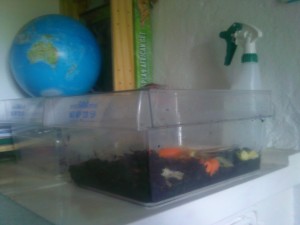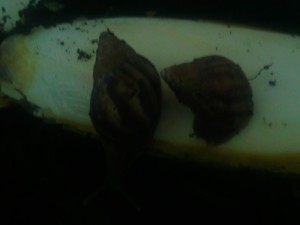How to make a suitable home for your giant land snail
 Giant land snails are considered to be great pets for a young child, as they are easy to look after. Before you buy yourself or your child a giant land snail you must consider it needs and make sure you have a suitable home for it.
Giant land snails are considered to be great pets for a young child, as they are easy to look after. Before you buy yourself or your child a giant land snail you must consider it needs and make sure you have a suitable home for it.
Generally your giant land snail should be kept in a large tank or vivarium that has a strong lid and lets plenty of air into the tank (we don’t want your snail suffocating). Ones that have transparent sides are good for watching your pet.
The vivarium shouldn’t be kept in direct sunlight as snails burn easily and overheating can kill them.
A good size for a tank for one giant land snail would be about 12 inches (length) by 10 inches (depth) by 12 inches (height). Obviously if you have more than one snail the tank should be bigger. Please not that if you have more than one snail, they are likely to produce vast numbers of babies (it is illegal to release them into the environment).
At the bottom of the tank you should have a couple of inches of substrate for the giant land snails to burrow in; this can be bought from garden centres. I find that Cocoa fibre is good. Don’t use peat as it is too acidic for the giant land snails.
Plants: You should put a variety of plants in your snail’s tank. This will reflect their natural habitat. Warning: make sure the plants aren’t poisonous.
Your snail should always have fresh food in its cage.
 Snails don’t really need a water bowl. They get enough water from the misting of their cage with water at least every other day. If you do provide a snail with a water bowl make sure it’s shallow enough so the snail won’t drown.
Snails don’t really need a water bowl. They get enough water from the misting of their cage with water at least every other day. If you do provide a snail with a water bowl make sure it’s shallow enough so the snail won’t drown.
It is a good idea to put a range of twigs and bark in your snail’s vivarium as this will give them something to explore.
It is very important you provide your snail with a cuttlefish bone as this provides your giant land snail with a calcium source. Other calcium sources, such as crushed egg shells, could be used instead of the cuttlefish bone.
It is important that whatever you put in your snail’s tank (with the exception of some foods) has been soaked for at least 24 hours. This should remove any harmful chemicals.
Never put rocks or stones in your snail’s tank. If they are climbing up the lid and they fall, they could crack their shell or worse.
Different species of giant land snails will need to be kept at different temperatures. Generally, the ideal temperature for most species will be 20°C to 28°C. You should always find out what the right temperature is for your specific species of giant land snail. Some of this info is on this site (click here to go to the archive for Giant African Land Snail Species and here to see the Giant American Land Snail Species).
Generally a good way to achieve the required temperature (especially in winter) is to buy a heat pad or mat. This should only go under half the tank and there should be no way the snail can burn itself.
A light in the tank isn’t necessary as snails are nocturnal and don’t need light. If you do decide ot put a light in make sure that there is no way the snail can reach it and/or get burnt.
Any questions? Comment below.
 May 28, 2010
·
May 28, 2010
·  Maddia (Admin) ·
Maddia (Admin) ·  6 Comments
6 Comments
 Tags: Animals, giant african land snails, Giant Land Snail Care, Pets · Posted in: Giant Land Snail Care, Giant Land Snail Information
Tags: Animals, giant african land snails, Giant Land Snail Care, Pets · Posted in: Giant Land Snail Care, Giant Land Snail Information



6 Responses
Great site. A lot of useful information here. I’m sending it to some friends!
Valuable info. Lucky me I found your site by accident, I bookmarked it.
your blog is so cool
Fab info, really helpful. Now I’m just worried because I asked my friend if I could have two of her baby snails and she’s given me ten!!! What can I do, I dont want to destroy them and I dont know anybody else who thinks snails are adorable. Please help!!!!!!
Hi Caz,
Many people think snails are cute but these people can be hard to find! I have three giant african land snails and plan on giving or selling the babies to a pet shop or garden centre – so this is a possibility for you. Many pet shops are keen to take these exotic creatures on as they can be hard to come by. The more information you can give them the better!
Another alternative is to advertise them for sale, either online or in shops/work places/schools near you. I know you can sell them on ebay, but to comply with their regulations you have to advertise them as ‘reptile food’. If you do sell them online you’ll have to make appropriate delivery arrangements (I believe they can be sent in the post, but provide them with enough food and make sure they’re travelling for as little time as possible, i.e don’t post on a Saturday if the collection isn’t until Monday).
You’ve said they are babies, so (depending on how old they are) you’ll have some time to decide what you’re going to do with them before they mature enough to start breeding ( they can lay upto 300 eggs EACH depending on the species).
If you do keep just two you are likely to still end up with more as they breed like rabbits, unless they are of different species, (although it is not recommended that you keep different species together).
Hope this has helped. :)
This is contracted from simply touching the snails in some cases, or handling them and then getting their mucus into an orifice like your eyes. Of course they can also be carrying a few other nastiness for you. Luckily none as of yet in the USA have been discovered with diseases.